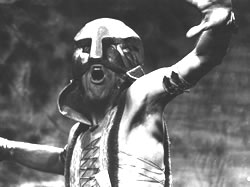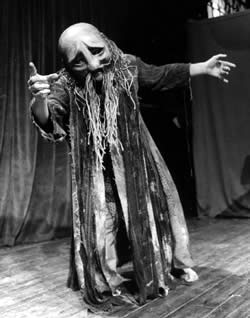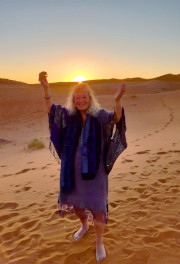The Dance Dramas of W. B. Yeats

Niema at Yeats' graveside
Having studied dance and choreographed performances for my own dance group, I was intrigued by Yeats’s Plays For Dancers. Where were they performed? Who were his dancers? What sort of dance did he have in mind? The questions were even more intriguing because Yeats didn’t use dance as a peripheral device, as something to enhance his plays, but as the core of the play itself; as a non-verbal development of the central action, the epiphany, even the climax. Dance was integrally woven into the texture of the plays.
The reason for Yeats’s fascination with dance became obvious to me when I understood his concept of theatre which was very different from the theatre of his day. He shunned naturalistic theatre - plays based on contemporary ideas and events prevalent in the work of George Bernard Shaw and Oscar Wilde. Yeats wanted his drama to by-pass the intellect, to excite the imagination rather than the mind. He believed that the world of events and ideas was transitory, passing, whereas the reality of the imagination was lasting. He wanted his theatre to communicate experiences which were outside the scope of reason, experiences which evoked the “intimacies, ecstasies and anguish of the soul-life.” He wanted his theatre to create magic, to be a mystical happening which lured the audience to “the edge of trance”. He wanted to create poems without words. Dance was the perfect solution. Through dance he could convey those “intuitive perceptions” that could be comprehended only through the pulses, “in that moment where everything is intelligible in one throb of the artery.”
I understood what Yeats wanted to do, but not how he did it. I understood it even less when I discovered that Yeats knew very little about dance and that the only dance available to him was ballet which he professed to detest. Before attempting to tackle the plays I needed to get some idea of what Yeats’s dances were like, I needed to visualize what he had in mind. But how was I to do this? His plays contained few stage directions, still fewer dance directions.
I thought my problem was solved when I discovered that Irish-born Ninette de Valois, who later founded the Royal Ballet Company in England, had been Yeats’s main dancer in the early performances of his dance plays. She was alive and well and living in London. What luck! Surely she would help me. I could hardly wait to write to her. But alas, her reply was devastating: “I do not answer queries on Yeats.”
(Some years later when I had the privilege of meeting Dame Ninette she explained her refusal: Years before she had toured America lecturing on ballet and had been delighted by the throngs of people who flocked to hear her. She found herself addressing capacity audiences. However, during question time her delight vanished. Most questions concerned W.B.Yeats. It was her association with the poet which drew the crowds, not an interest in ballet. From then on, she did not answer queries on Yeats.) But I am getting ahead of my story.

Brian Stavechy asThe Young Man
in At The Hawkes's Well

Cedric Smith as the Old Man
in At The Hawkes's Well
When I came to London in the early 70’s to complete a PhD thesis on the dance in Yeats’s theatre, Brian came with me. Together we formed the Yeats Theatre Company. Michael, Yeats’s son, was one of the sponsors. We began rehearsing two of the Dance plays: At the Hawk’s Well and The Cat and the Moon, both using masks. Cedric Smith, the Canadian actor/musician happened to be visiting me at the time and was roped into composing music for both plays and acting as one of the leads. Another visiting friend, the Canadian sculptor, John Meighen, agreed to make the masks. This time I had full control over every aspect of the production.
To our delight, Omnibus, one of the BBC’s flagship programs was researching a program on Yeats. The producer, Stephen Cross, heard about our rehearsals and arranged to film them. I suggested he also interview Dame Ninette de Valois, but warned that she “does not answer queries on Yeats”. However, I thought she might relent for the BBC. I told Stephen how anxious I was to meet her and made him promise that if she agreed to be interviewed he would take me along as his assistant.
Dame Ninette de Valois did make allowances for the BBC and Stephen Cross kept his promise to me. The interview took place in her home. I was hugely excited. This was my big chance to ask the questions that only she could answer. Realizing I would be too nervous to remember the interview, I secretly taped it. My questions were so detailed, that at one point, impressed with the erudition of a mere BBC assistant, Dame Ninette said, “My goodness, you BBC people do your research thoroughly.” The interview was incredible; the atmosphere relaxed and easy. Dame Ninette was delightful - warm, expansive, chatty. She said things like, “I’ll tell you something but you are not to tell another soul” and proceeded to reveal some succulent anecdote involving Yeats, some admission, some prized bit of information.
In the end I was moved to confess I was not a BBC assistant but a student of Yeats and was in the midst of directing and choreographing two of his dance plays. She was thrilled by the revelation and asked if she could attend a rehearsal. Now it was my turn to be thrilled. She came not only to a rehearsal but to a performance and brought T.S. Eliot’s wife, Valerie, with her.
The plays were a huge success. It was the first time they had been produced professionally in the U.K. since Yeats’s death. Several renowned Yeats critics came to see them. The BBC filmed them and so did the University of London. I still have the beautifully-made costumes and masks, the playbills, reviews, letters of thanks, the films, and of course the tapes. It would be wonderful if someone secured the collection for an exhibition on Yeats or just to preserve it. I’m hoping.
To receive details on how to order a signed dedicated book, or for any other queries, please contact niema@talk21.com
